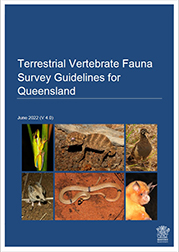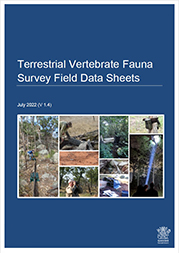Terrestrial vertebrate fauna survey guidelines

The Terrestrial Vertebrate Fauna Survey Guidelines for Queensland outline the minimum survey requirements, survey standards and appropriate practice for the survey of terrestrial vertebrate fauna in Queensland. The document provides details of appropriate standard methods and associated equipment for the systematic survey of terrestrial vertebrate fauna, as well as recommendations on animal handling, improving survey adequacy, storing and managing survey data, and undertaking habitat assessment.
Field data sheets

View the field data sheets that are associated with the survey methods outlined in the Terrestrial Vertebrate Fauna Survey Guidelines for Queensland.
- Datasheet description and purpose
- Site information
- Diurnal bird surveys
- Herpetofauna searches
- Elliott, pitfall, funnel, cage and turtle trapping
- Arboreal spotlight and nocturnal call playback
- Incidental records on survey sites
- Incidental fauna sightings
- Bat trapping
- Camera trapping
- Acoustic recording
- Hair tubes
- Scat and sign searches
- Vehicle and foot road transects
- Amphibian search
- Waterbird/shore bird survey
Targeted species survey guidelines
Guidelines for the targeted survey of Queensland’s threatened species, as listed under the Nature Conservation Act 1992, are also being developed and will be posted as they are completed. These targeted guidelines provide details of appropriate survey approaches and effort to maximise the likelihood of detecting threatened species, as well as information on identification, current known distribution, habitat preferences, and ethical and handling considerations.
The Queensland Government threatened species survey guidelines complement the existing survey guidelines for species listed nationally under the Environmental Protection and Biodiversity Conservation (EPBC) Act 1999, as provided by the Commonwealth Department of Agriculture, Water and the Environment.
Download the targeted species survey guidelines
Targeted species survey guidelines are available for selected threatened species. Other targeted species guidelines will be added and existing ones updated on a regular basis.
Frogs
- Adelotus brevis, tusked frog
- Crinia tinnula, wallum froglet
- Litoria cooloolensis, Cooloola sedgefrog
- Litoria freycineti, wallum rocketfrog
- Litoria olongburensis, wallum sedgefrog
- Litoria pearsoniana, cascade treefrog
Reptiles
- Ctenotus capricorni, Capricorn ctenotus
- Ctenotus schevilli, black-soil rises ctenotus
- Ctenotus serotinus, gravel-downs ctenotus
- Egernia rugosa, yakka skink
- Acanthophis antarcticus, common death adder
- Hemiaspis damelii, grey snake
Birds
- Probosciger aterrimus, palm cockatoo
- Calyptorhynchus lathami, glossy black-cockatoo
- Grantiella picta, painted honeyeater
Mammals
- Vombatus ursinus, bare-nosed wombat
- Sminthopsis douglasi, Julia Creek dunnart
- Petrogale purpureicollis, purple-necked rock-wallaby
- Petrogale sharmani, Sharman’s rock-wallaby
- Hipposideros cervinus, fawn leaf-nosed bat
- Hipposideros diadema reginae, diadem leaf-nosed bat
- Hipposideros stenotis, northern leaf-nosed bat
- Macroderma gigas, ghost bat
- Murina florium, flute-nosed bat
- Rhinonicteris aurantia, orange leaf-nosed bat
- Taphozous australis, coastal sheathtail bat